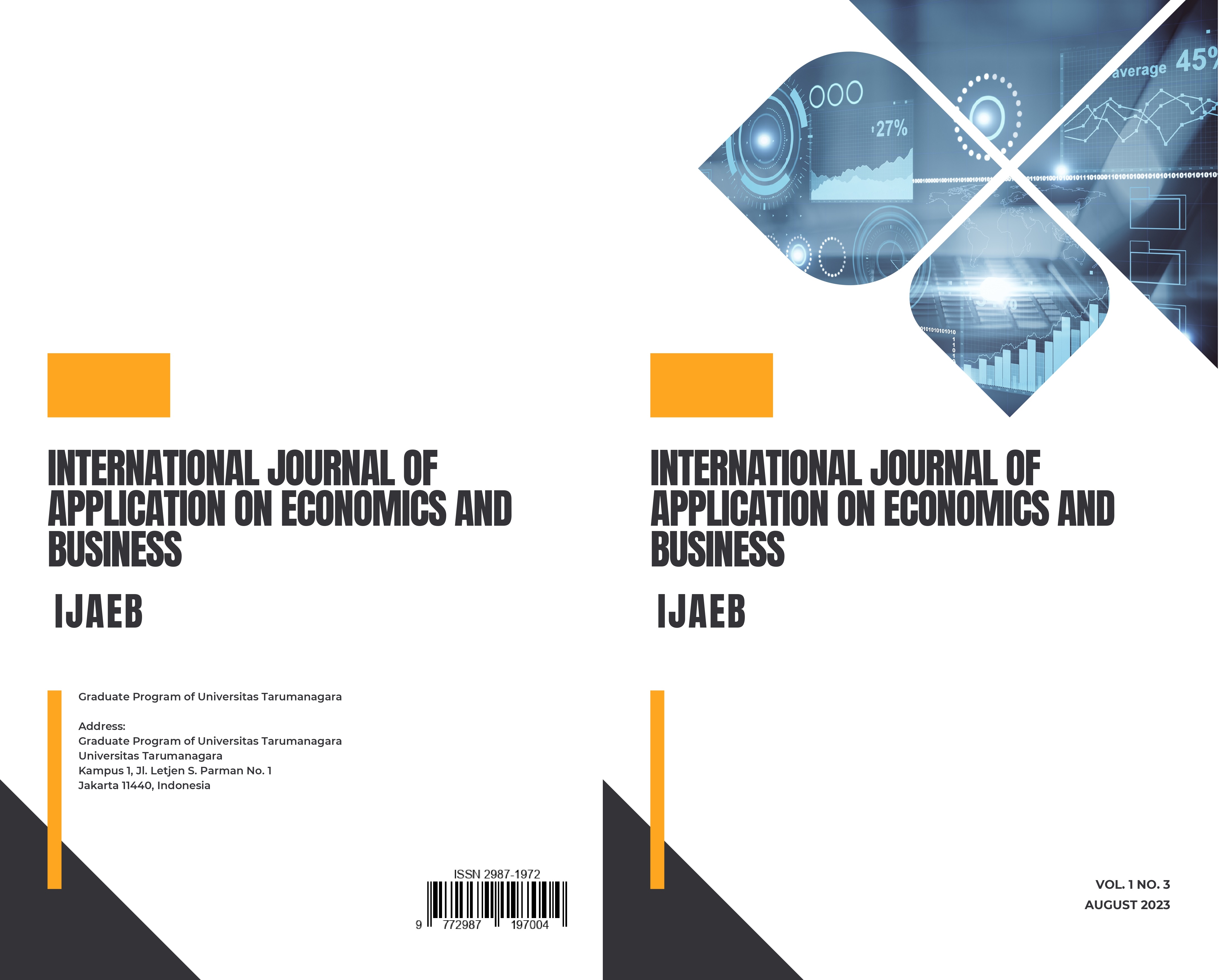INDONESIA’S STOCK MARKET LIQUIDITY: THE IMPACT OF COVID-19 PANDEMIC AND SOCIAL DISTANCING
Main Article Content
Abstract
The purpose of this study was to obtain empirical evidence regarding the effects of COVID-19 pandemic on Indonesia’s Stock Market Liquidity. COVID-19 was observed with three variables (the growth of the total number of confirmed cases, the growth of the number of deaths, and stringency index). This study incorporated market capital, return of Jakarta Composite Index (JCI), and exchange rates of Rupiah against U.S. Dollar as control variables. The source of data of this research was from IHSG transactions, COVID-19 updates on WHO’s website, and exchanges rate historical data from Bank Indonesia’s website from March 2nd, 2020 to December 30th, 2020. Hypothesis testing is done by multiple regression analysis using EViews 12. The findings of this research indicate that COVID-19 did not correlate significantly to the liquidity by the depth measure. The implication of this study is to provide new insight regarding the effects of pandemic towards Indonesia’s stock market liquidity, to become a reference to the future research because the result differs from one country to another one, to provide new insight such as knowledge regarding the higher return and the strengthening of Rupiah means the higher stock market illiquidity by its depth, in order to give guidance for investors’ decision-making process and to give references for the next research.
Article Details

This work is licensed under a Creative Commons Attribution-NonCommercial-ShareAlike 4.0 International License.
This journal provides immediate open access to its content on the principle that making research freely available to the public supports a greater global exchange of knowledge.
IJAEB by Graduate Program of Universitas Tarumanagara is licensed under a Creative Commons Attribution-NonCommercial-ShareAlike 4.0 International License.. Permissions beyond the scope of this license may be available at https://journal.untar.ac.id/index.php/ijaeb
References
Erlinawati, Ira dan Imron Mawardi. 2015. Pengaruh Jumlah Saham Beredar, Harga Saham, dan Presentase Saham Publik Terhadap Likuiditas Saham Perusahaan yang Listing di JII Periode 2013. Jurnal Ekonomi Syariah Teori dan Terapan, 2(2),130-146. https://doi.org/10.20473/vol2iss20152pp130-146.
Baig, Ahmed, Hassan Anjum Butt, Omair Haroon, Syed Aun R. Rizvi. 2020. Deaths, panic, lockdowns, and US equity markets: The case of COVID-19 pandemic. Finance Research Letters, https://doi.org/10.1016/j/frl/2020.101701.
Mdaghri, Anas Alaoui, Abdessamad Raghibi, Cuong Nguyen Thanh, dan Lashen Oubdi. 2020. Stock Market Liquidity, The Great Lockdown, and The COVID-19 Global Pandemic Nexus in MENA Countries. Review of Behavioral Finance 13(1): 51-68.
Al-Awadhi AM, Alsaifi K, Al-Awadhi A, Alhammadi S. 2020. Death and contagious infectious diseases: Impact of the COVID-19 virus on stock market returns. J Behav Exp Finance. http://dx.doi.org/10.14414/jebav.v24i1.2574.
Eleftheriou, Konstantinos & Patsoulis, Patroklos, 2020. "COVID-19 Lockdown Intensity and Stock Market Returns: A Spatial Econometrics Approach," MPRA Paper 100662, University Library of Munich, Germany
Nguyen, Cuong Thanh, Phan Thanh Hai, dan Huyen Khanh Nguyen. 2021. Stock Market Returns and Liquidity during the COVID-19 Outbreak: Evidence from the Financial Services Sector in Vietnam. Asian Journal of Economics and Banking, 5(3), https://doi.org/10.1108/AJEB-06-2021-0070.
Taleb, Nassim Nicholas. 2007. The Black Swan: The Impact of the Highly Improbable. Random House: New York City.
Fama, Eugene F. 1970. Efficient Capital Markets: A Review of Theory and Empirical Work. The Journal of Finance (25): 383-417. https://doi.org/10.2307/2325486.
Kyle, Albert S. 1985. Continuous Auctions and Insider Trading. Econometrica 53(6): 1315-1335. https://doi.org/10.2307/1913210.
Robinson, John P., Phillip R. Shaver, dan Lawrence S. Wrightsman. 1991. Measures of Personality and Social Psychological Attitudes. Academic Press 1-15. https://doi.org/10.1016/B978-0-12-590241-0/50005-8.
Lybek, Tony dan Abdourahmane Sarr. 2002. Measuring Liquidity in Financial Market. IMF Working Paper No.2002/232. https://EconPapers.repec.org/RePEc:imf:imfwpa:2002/232.
Alan, N.S., Hua, J., Peng, L. and Schwartz, R.A. 2015. Stock Resiliency and Expected Returns. New York: Baruch College Zicklin School of Business.
McKibbin, Warwick J dan Roshen Fernando. 2020. The Global Macroeconoic Impacts of COVID-19: Seven Scenarios. CAMA Working Paper No.19/2020. https://dx.doi.org/10.2139/ssrn.3547729.
https://finance.yahoo.com/quote/%5EJKSE?p=^JKSE&.tsrc=fin-srch
https://ourworldindata.org/coronavirus/country/indonesia
https://www.bi.go.id/id/statistik/informasi-kurs/transaksi-bi/default.aspx
Amihud, Yakov. 2002. Illiquidity and Stock Returns: Cross-section and Time-series Effects. Journal of Financial Markets, 5 (1): 31-56. https://doi.org/10.1016/S1386-4181(01)00024-6.
Chung, Kee H and Hao Zhang. 2014. A Simple Approximation of Intraday Spreads Using Daily Data. Journal of Financial Markets 17:94-120. https://doi.org/10.1016/j.finmar.2013.02.004
Hale, Thomas, Noam Angrist, Rafael Goldszmidt, Beatriz Kira, Anna Petherick, Toby Phillips, Samuel Webster, Emily Cameron-Blake, Laura Hallas, Saptarshi Majumdar, dan Helen Tatlow. 2021. A Global Panel Database of Pandemic Policies (Oxford COVID-19 Government Response Tracker). Nature of Human Behavior (5), 529-538. https://doi.org/10.1038/s41562-021-01079-8.
Priscilla, Sherin, Saarce Elsye Hatane, and Josua Tarigan. 2022. COVID-19 Catastrophes and Stock Market Liquidity: Evidence From Technology Industry of Four Biggest ASEAN Capital Market. Asia-Pacific Journal of Business Administration. https://doi.org/10.1108/APJBA-10-2021-0504



